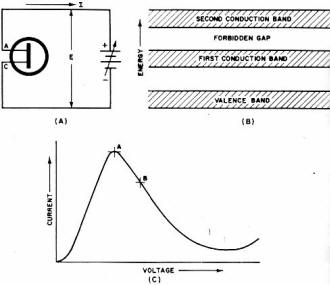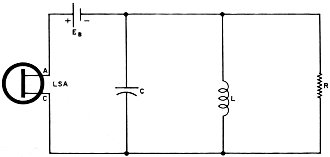|
February 1969 Electronics World
 Table of Contents
Table of Contents
Wax nostalgic about and learn from the history of early electronics. See articles
from
Electronics World, published May 1959
- December 1971. All copyrights hereby acknowledged.
|
Prior to the advent of high
frequency solid state devices like Gunn diodes, working at or above a couple GHz -
even at low power - required the use of cavity oscillators such as klystrons and
magnetrons. They were bulky, espensize and electrically very inefficient. This
article outlines the theory of bulk oscillators as developed by Dr. John A. Copeland,
of Bell Labs, and points out the peculiarities of the LSA (limited space-charge
accumulation) mode that makes it possible to obtain 20 milliwatts of power at 88 GHz.
Use of gallium arsenide (GaAs) enabled designers to construct receiver circuits into
the mm-wave region without the need for klystrons, thereby reducing cost, size, and
power requirements.
Solid-State LSA Microwave Diodes
By David L. Heiserman
With a bulk semiconductor operating in the limited space-charge accumulation mode,
it is possible to produce 20 mW output at 88 GHz.

Dr. John A. Copeland adjusts an experimental solid-state millimeter
oscillator which replaces cumbersome klystron.
It has taken nearly twenty years of research, but the communications engineer's dream
of a practical solid-state microwave energy source is about to come true. Development
in r.f. transistor and tunnel-diode circuitry were painfully slow and until 1963 when
J. B. Gunn announced the discovery of his 1-GHz bulk semiconductor oscillator, a sweeping
revolution in solid-state microwave electronics always seemed to lie somewhere just beyond
reach.
Although Gunn's device stimulated a great deal of research activity with bulk semiconductors,
it has not provided the final answer to the solid-state microwave problem. (See "Gunn
Oscillators", Electronics World, September, 1967.) One major difficulty with the Gunn
device is that its operating frequency is determined primarily by the time it takes a
space-charge to travel from the cathode to the anode. Unfortunately, shortening the active
region in order to increase operating frequency also reduces the area available for dissipating
heat generated by the moving space-charge.
Early in 1967, Dr. John A. Copeland of Bell Telephone Labs showed that it is possible
to "quench" the Gunn space-charge and let an external LC circuit rather than the transit
time of a space-charge determine the operating frequency. The implications were that
the active region of the bulk semiconductor may be made much longer to facilitate heat
dissipation without severely limiting the operating frequency.
This article outlines the theory of bulk oscillators in general, and points out the
peculiarities of the LSA (limited space-charge accumulation) mode that makes it possible
to obtain 20 milliwatts of power at 88 GHz.
Negative Resistance
Both Gunn and LSA diodes operate on principles involving negative-resistance effects
in bulk semiconductors. Unlike the conventional negative-resistance device, bulk semiconductors
are simply pieces of highly purified n-type material - no p-n junctions enter into the
structure at all. It is the quantum structure of bulk materials such as gallium arsenide
that is responsible for junctionless negative-resistance effects.

Fig. 1. (A) A simple bulk diode circuit that may be used as a Gunn
oscillator. (B) Energy diagram of "n"-type semiconductor is similar to that of gallium
arsenide. The negative-resistance curve (C) is typical of all bulk semiconductors.
Fig. 1B illustrates the electron structure of n-type GaAs. Note that there are two
conduction bands separated by a forbidden gap. When an external d.c. source is below
a certain threshold value, determined partly by the width of the forbidden gap, all electrons
flow through the low-energy conduction band. Increasing the applied voltage slightly
beyond the threshold potential gives a few electrons enough extra energy to jump the
forbidden gap and flow through the high-energy conduction band. Any further increase
in applied voltage simply increases the percentage of electrons using the high-energy
band.
In semiconductors such as the GaAs diode, the electrons behave differently in the
two conduction bands. The band that carries the most current tends to dominate the over-all
behavior of the device. Electrons in the low-energy band flow through the diode in a
smooth stream much like any ordinary semiconductor. Electrons in the high-energy band,
however, collect into a small packet or space-charge near the cathode, and travel in
a group through the high-energy band toward the anode. When this space-charge disappears
into the anode, all current flows through the low-energy band until another space-charge
begins to form at the cathode.
One other difference between the two conduction bands concerns the drift velocity
of the carrier electrons. The free electrons in the low-energy band travel through the
material with a much higher average velocity than does the space-charge in the high-energy
band. Thus, when electrons are using the low-energy band, the average current through
the device is higher.
The fact that the current flow through the bulk GaAs diode grows smaller when the
applied voltage is increased '1 above a certain threshold value shows that the device
would have the negai tive-resistance characteristic curve as illustrated in Fig. lC.
A forward d.c. potential large enough to drive the bulk diode deep into its negative-resistance
region will force most electrons to use the slow-moving, high-energy conduction band
as long as a space-charge is present to carry them via that route. However, as soon as
the space-charge disappears into the anode, electrons have no choice. but to rush through
the high-velocity band until the next space-charge begins to form.
Without the benefit of external tuned circuitry, the bulk semiconductor diode will
oscillate in the Gunn mode at a frequency determined by the transit time of the space-charge.
To increase the operating frequency, the device must be shortened in the direction of
current flow, and this operation decreases the device's ability to dissipate heat.
An external LC circuit with a time-constant shorter than the transit time of the diode's
space-charge may be connected into a Gunn-type circuit, as shown in Fig. 2.

Fig. 2 - An LSA diode in the negative-resistance region delivers energy
back into the diode, quenching the space charge. Operating frequency is the resonant
frequency of the LC circuit.
If the diode is properly doped for LSA operation, each birth of a high-energy band
space-charge will be followed by a reverse-biasing half-cycle from the tuned circuit.
This reverse-biasing energy will quench a newly formed space-charge, and reset the diode
to its high conductance state until another space-charge can form. During the high-conduction
state of the diode, the tuned circuit has a chance to move through its positive half-cycle
and restore energy lost during the negative swing. By limiting the space-charge accumulation
to a small fraction of its mature value, and by letting the tuned circuit determine the
operating frequency, the bulk diode circuit can operate effectively at frequencies exceeding
50 GHz with power outputs near 100 m W.
Dr. Copeland developed the LSA diode as a result of a careful computer analysis of
the Gunn effect. He found that a diode can operate in the LSA mode only if the product
of the electron density, N, times the length of the device, L, is nearly equal to a very
critical value of 1012 donors per square centimeter. A bulk diode having an
NL product less than 1012 will not oscillate at all because the negative-resistance
effect is spread over too much of the high-energy conduction band. On the other hand,
a diode with an NL product greater than 1012 will operate only in the Gunn
mode because the LC circuit will not have enough energy to reverse-bias and quench such
strong space-charges.
An analysis and comparison of frequencies and power limits for Gunn oscillators, LSA
circuits, tunnel-diode oscillators, and small klystron circuits cannot be truly meaningful
at this time. Microwave technology is in such a state of flux that any figures published
today may be obsolete tomorrow.
Many observers believe solid-state microwave devices, such as the Gunn oscillator
and LSA diode, are pushing the communications industry toward the brink of a sweeping
solid-state revolution. To be sure, these devices will find a place in the industry,
but only where their advantages will pay off - not in vast, safe, well-manned, air-conditioned,
megawatt communications complexes; but in tiny, remote radio stations and in the incredibly
demanding environments of space.
Posted November 22, 2017
|











